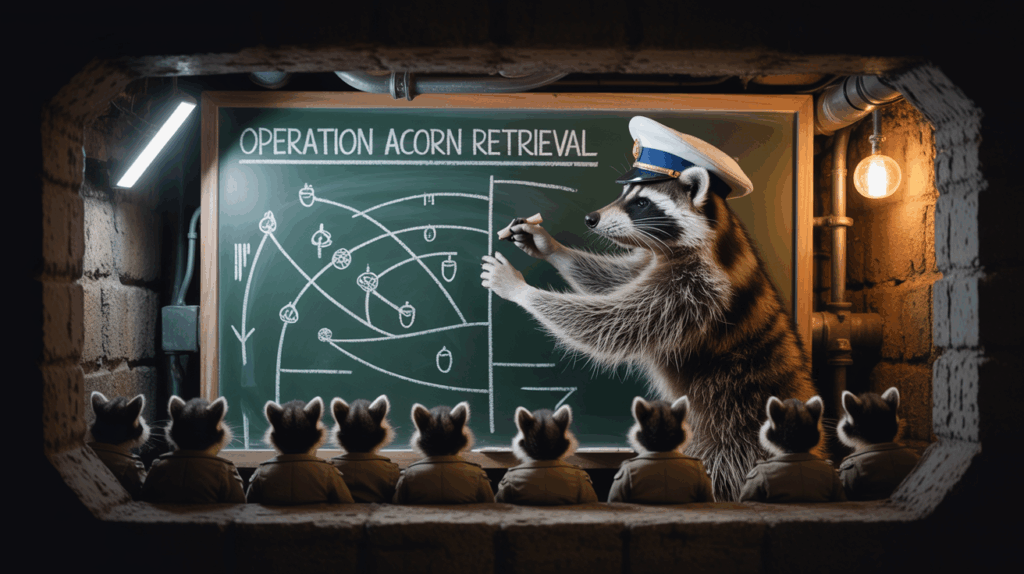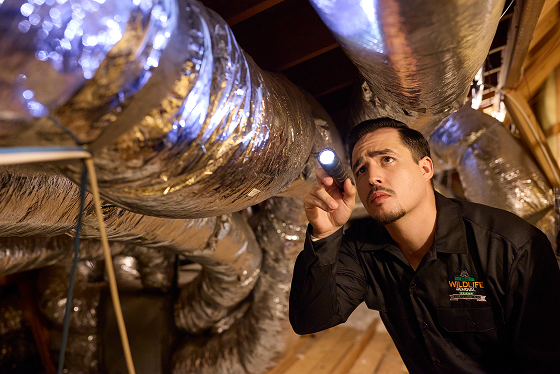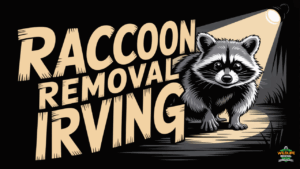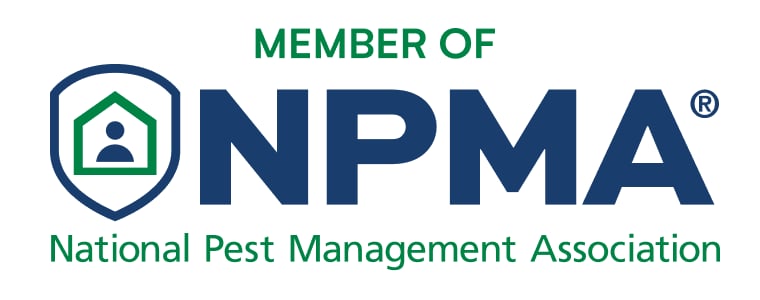That toppled trash bin and those late-night scratching noises might seem harmless at first—until you realize there’s a raccoon making itself at home in your attic. Up there, it’ll shred your insulation, leave droppings in every corner, and chew through your wiring.
The longer the animal stays, the worse it gets. As soon as you spot the signs, call AAAC Wildlife Removal Irving—the trusted wildlife removal company locals count on. We’ll kick them out fast and make sure they don’t come back.
Why are Raccoons a Problem in Irving, TX
Irving Texas is home to a number of wild animals, including raccoons, that share its many natural green spaces – and coupled with how close it is to water sources like the Trinity River and Grapevine creek, Irving is the perfect set up for raccoons to thrive.

From these green pockets, raccoons easily find their way to neighborhoods and start their shenanigans while foraging food and invading homes.
Here are a few major concerns with raccoons
1. Diseases
Rabies has always been the main concern when it comes to wild animals in Texas. In Dallas County, raccoons are the fourth most common rabies-infected animal according to the 2024 Texas annual rabies report. Of the 559 cases, there were 33 positive cases of rabies. The most cases goes to dogs, cats, and bats.
Infected raccoons can easily infect your pets through bites and scratches so it’s better to be safe and keep these animals far from your home.
Besides rabies, raccoons are also known to carry leptospirosis, distemper, roundworm, tularemia, and salmonellosis – all nasty infections you don’t want anywhere near your family.
2. Attic Invasion
For raccoons, attics are the perfect place to raise their young – for them, they’re like five star hotels! Plenty of materials to make a nest (your insulation), protection from the elements and predators, and very close to food sources (your trash bins).
From the trees, they’ll access your roof by crossing branches, find any opening they can use to get access to your attic and then they’d bring the whole family in!
3. Nightly Disturbance
Raccoons, being crepuscular, and nocturnal creatures, are pretty active at dawn, evening, and dusk. This is typically the time when they start to forage or scavenge food from bins and drag them to your attic.
This activity causes quite a racket especially at night when it’s quiet and there’s not a lot of other sounds to drown the raccoons’ noises. Raccoons chewing through your insulation and wirings would also jolt you awake in the middle of the night if you let them stay.
4. Nasty Odors
Hygiene isn’t exactly on top of the raccoons list of priorities and it’ll do its business wherever it feels like doing so. You’d usually see poo at the base of trees, in your roof, the corners of your attic, in your torn up insulation, you name it!
Besides the poo there are also bits and pieces of trash and leftover food from your garbage bin that it dragged into your attic. In time, these would accumulate and build up a smell that reaches your living spaces.
Signs of Raccoon Infestation
You may not see these wildlife directly but you’ll surely spot signs that they are on your property. Knowing they are present is critical because when it comes to raccoon infestation, time is of the essence. The sooner you know you have a wildlife problem, the sooner you can do something about it.
Here are a few signs that you have a pest raccoon living in your property:
1. Droppings – In your yard, you will usually find these at the base of trees, or decks and patios. You can also find them in sheds, garages, and barns. These droppings are typically tubular, dark in color and about 2-3 inches in size.
2. Evening noises – As mentioned above, they make quite a ruckus at night when they make their nests and drag food from your garbage bins to feed their young. Loud thumping and scratching and pretty typical with raccoons as they are larger than squirrels.
3. Knocked over trash cans – Garbage cans are the raccoons main source of food supply in Irving’s suburban neighborhoods. They’ll climb and dive over your bins, and being heavier than squirrels, they would topple them over, spilling all its contents.
4. Tracks, paw prints – raccoons with their muddy little paws often track mud and leave prints around in and around your home. You’d find this in their entry points, the pavement, downspouts and windowsills.

DIY vs Getting a Professional
I mean, we get it, you’re trying to see if you could save a few bucks and try to remove the nuisance yourself. But trying to remove a wild animal without the proper training and equipment is usually not worth the risk and effort. Why, you ask?
1. Texas has strict wildlife laws.
In Texas, raccoons are categorized as fur-bearing animals which means there are strict rules on how you can handle them. If they are causing damage, which most likely are in your home, then they’re considered a nuisance and can be removed without permit.
However, you cannot transport or relocate them anywhere unless you obtained permission from the Texas Parks and Wildlife Department because of rabies. It’s considered a class C misdemeanor to transport them to, from, and within the state and could result in a fine or jail time.
2. Raccoons bite and scratch.
Raccoons will not let you take them without a fight. Especially when cornered and if they have with them their young, which is often the case with raccoons in attics. They’ll try to bite and scratch you if you attempt to come near.
And with their size (usually the size of a small-medium dog), they can be quite intimidating. I don’t know about you but, I’m not going anywhere near an animal with sharp teeth and claws.
3. You risk contracting diseases.
The dreaded rabies is the primary concern when it comes to transmittable diseases you can get from a raccoon. However, as discussed earlier, there are at least half a dozen other dangerous diseases a raccoon could be carrying.
Leptospirosis, the disease you can get from rodents, is also quite prevalent in raccoons. Then there’s tularemia, raccoon roundworms, and a bunch of other nasty stuff you can get from a bite or simply a scratch. When it comes to these diseases, you don’t want to roll the dice.
4. They’re not easily trapped.
So you’re thinking, I ain’t gonna come near that thing – I’ll just buy a trap in Walmart and ambush the darn thing. But what trap are you going to buy? What bait are you going to use? Where are you going to place the trap?
Raccoons are intelligent and clever little animals, they know when something’s amiss in their environment. That trap you set? Would certainly look suspicious to them. In their mind, “That thing looks suspicious – I ain’t going anywhere near that funny looking contraption.”

Why AAAC Wildlife Removal is the Solution to all your Wildlife Woes
When it comes to handling a serious wildlife issue, calling in the pros is your best move. In Irving, Texas, AAAC Wildlife Removal is the go-to name for fast, humane, and effective removal services of everything from raccoons and bats to rats and squirrels. Our animal services are designed to not only trap and remove animals but also protect your property from future invasions. For trusted results, families often rely on Irving wildlife removal experts who understand the area’s unique challenges better than national chains or generic Irving pest control companies.
So why AAAC Wildlife Removal, you say?
30 Years of Experience
We’ve been doing this a long time. Since 1995, we’ve helped the Irving community deal with every kind in Irving animal control like rodent control and raccoon control scenario imaginable—from stubborn attic squirrels to an unexpected opossum under the deck. That level of experience helped us grow into a national critter control company with over 20 locations across the U.S., always with a local team ready to respond quickly.
Certified Technicians
Every technician we send to your property is certified by the Texas Parks and Wildlife Department. They’re trained in bat removal, squirrel removal, rat removal, and even dead animal removal, using modern equipment and proven techniques to solve complex cases of nuisance wildlife. From start to finish, you’re in expert hands with people who know how to trap and remove animals the right way.
Full-Service Solution
We don’t just trap and leave. Our team handles everything: cleanup, decontamination, exclusion repairs, and follow-up. Whether it’s sealing entry points after a rat infestation or sanitizing after critter activity, we leave your home cleaner, safer, and more secure. That’s what makes AAAC Wildlife Removal the one-stop shop for removal services and trusted animal services in Irving.
Contact us at AAAC Wildlife Removal Irving, TX
Raccoons might look harmless, but in a place like Irving, TX, they’re much more than a nighttime nuisance. With Irving’s mix of suburban neighborhoods, wooded greenbelts, and easy access to food and shelter, raccoons thrive—especially in attics, chimneys, and crawlspaces. That’s where Irving raccoon removal becomes a real necessity, helping residents deal with the mess, noise, and long-term damage these critters can cause.
The problem isn’t just the damage to insulation or ductwork—it’s also the health risks. Raccoons often leave behind droppings near entry points, under decks, or around the base of trees, which can carry parasites and diseases. Professional humane wildlife control services don’t just trap the animal—they also help sanitize the area and seal off access points to prevent future invasions.
Effective wildlife removal in Irving combines prevention, repair, and exclusion techniques. Whether you’re dealing with a persistent raccoon, a skunk under the deck needing skunk removal, bats in the attic that require Irving bat removal, snakes lurking near sheds that call for snake removal, or even nuisance birds that demand bird control, a licensed pest control expert can help protect your home. By hiring local critter pros who know the habits and hiding spots of urban wildlife, you’re not just removing animals—you’re working to solve your wildlife problem and reclaim your peace of mind.
Frequently Ask Questions (FAQ)
Who to call to remove a raccoon near me?
If you’ve discovered a raccoon in your attic, garage, or yard, the safest option is to call a licensed wildlife removal service. AAAC Wildlife Removal specializes in humane raccoon removal, exclusion, and cleanup to protect your home and family. Our trained technicians know how to locate entry points, remove raccoons safely, and prevent them from coming back.
How to get rid of raccoons in Texas?
Getting rid of raccoons in Texas requires more than setting a trap. These animals are protected by state wildlife laws, so removal must follow Texas Parks & Wildlife guidelines.
AAAC Wildlife Removal offers professional raccoon control across Texas, using humane one-way doors, exclusion methods, and repairs to keep raccoons out of attics and crawlspaces long-term.
How much to relocate a raccoon?
The cost to remove and relocate a raccoon typically depends on factors like property size, number of raccoons, and the level of damage.
On average, professional raccoon removal services can range between $300 and $600, with cleanup and attic restoration adding to the total if damage is extensive. AAAC Wildlife Removal provides free inspections and upfront pricing so you’ll know exactly what to expect before work begins.
How do you permanently get rid of raccoons?
The only permanent way to get rid of raccoons is to combine humane removal with professional exclusion and repair. Simply trapping or scaring them off won’t stop them from coming back if entry points remain open.
AAAC Wildlife Removal seals access holes, installs one-way exit devices, and restores damaged areas to ensure raccoons stay out for good.
Will homeowners insurance cover raccoon removal?
Most homeowners insurance policies do not cover the cost of raccoon removal because it’s considered a preventable maintenance issue. However, some policies may cover repairs if the raccoons caused sudden and accidental damage, like chewing electrical wiring or damaging ductwork.
It’s always best to check with your insurance provider, and AAAC Wildlife Removal can provide detailed reports to support your claim if coverage applies.











